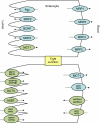The role of transporters in the pharmacokinetics of orally administered drugs
- PMID: 19568696
- PMCID: PMC2719753
- DOI: 10.1007/s11095-009-9924-0
The role of transporters in the pharmacokinetics of orally administered drugs
Abstract
Drug transporters are recognized as key players in the processes of drug absorption, distribution, metabolism, and elimination. The localization of uptake and efflux transporters in organs responsible for drug biotransformation and excretion gives transporter proteins a unique gatekeeper function in controlling drug access to metabolizing enzymes and excretory pathways. This review seeks to discuss the influence intestinal and hepatic drug transporters have on pharmacokinetic parameters, including bioavailability, exposure, clearance, volume of distribution, and half-life, for orally dosed drugs. This review also describes in detail the Biopharmaceutics Drug Disposition Classification System (BDDCS) and explains how many of the effects drug transporters exert on oral drug pharmacokinetic parameters can be predicted by this classification scheme.
Figures






References
-
- {'text': '', 'ref_index': 1, 'ids': [{'type': 'PubMed', 'value': '990323', 'is_inner': True, 'url': 'https://pubmed.ncbi.nlm.nih.gov/990323/'}]}
- Juliano RL, Ling V. A surface glycoprotein modulating drug permeability in chinese hamster ovary cell mutants. Biochim. Biophys. Acta. 1976;455:152–162. - PubMed
-
- {'text': '', 'ref_index': 1, 'ids': [{'type': 'PubMed', 'value': '10706193', 'is_inner': True, 'url': 'https://pubmed.ncbi.nlm.nih.gov/10706193/'}]}
- Fromm MF. P-glycoprotein: a defense mechanism limiting oral bioavailability and CNS accumulation of drugs. Int. J. Clin. Pharmacol. Ther. 2000;38(2):69–74. - PubMed
-
- {'text': '', 'ref_index': 1, 'ids': [{'type': 'PubMed', 'value': '12750437', 'is_inner': True, 'url': 'https://pubmed.ncbi.nlm.nih.gov/12750437/'}]}
- Landowski CP, Sun D, Foster DR, Menon SS, Barnett JL, Welage LS, et al. Gene expression in the human intestine and correlation with oral valacyclovir pharmacokinetic parameters. J. Pharmacol. Exp. Ther. 2003;306(2):778–786. - PubMed
-
- {'text': '', 'ref_index': 1, 'ids': [{'type': 'PubMed', 'value': '15618657', 'is_inner': True, 'url': 'https://pubmed.ncbi.nlm.nih.gov/15618657/'}]}
- Mizuno N, Sugiyama Y. Drug transporters: their role and importance in the selection and development of new drugs. Drug Metab. Pharmacokinet. 2002;17(2):93–108. - PubMed
-
- {'text': '', 'ref_index': 1, 'ids': [{'type': 'PubMed', 'value': '15771225', 'is_inner': True, 'url': 'https://pubmed.ncbi.nlm.nih.gov/15771225/'}]}
- Wu CY, Benet LZ. Predicting drug disposition via application of BCS: transport/absorption/ elimination interplay and development of a biopharmaceutics drug disposition classification system. Pharm. Res. 2005;22(1):11–23. - PubMed

